Strategic Management Report: Charles Schwab in Financial Services
VerifiedAdded on 2023/02/01
|13
|3395
|53
Report
AI Summary
This report provides a detailed analysis of the financial services sector, focusing on the internal and external environments and the competitive landscape. It uses frameworks like PESTLE and Five Forces to assess the industry's attractiveness and dynamics. The report highlights Charles Schwab as a leading global company, examining its strengths, core competencies, and strategic positioning within the industry. It explores the company's value chain activities, including inbound and outbound logistics, operations, marketing, sales, and service. The analysis also includes strategic grouping and market segmentation to understand Charles Schwab's competitive advantages and areas for differentiation. The report concludes by emphasizing the importance of innovation and strategic adaptation for Charles Schwab to remain competitive and meet customer expectations in the evolving financial services market. The report examines the company's diverse business, broad product portfolio, and customer service.

Name of Student
Name of College
Authors Note:
Name of College
Authors Note:
Paraphrase This Document
Need a fresh take? Get an instant paraphrase of this document with our AI Paraphraser
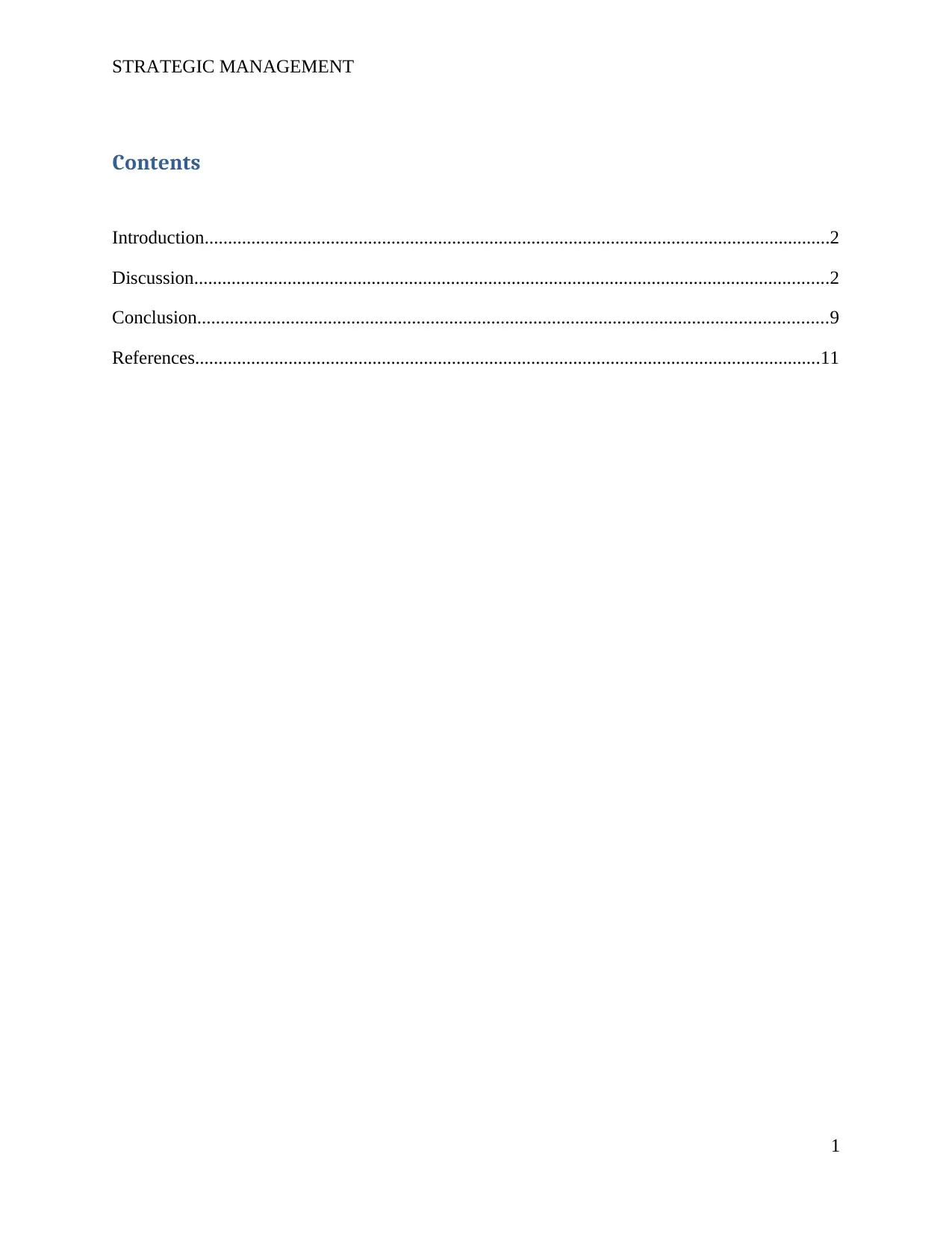
STRATEGIC MANAGEMENT
Contents
Introduction......................................................................................................................................2
Discussion........................................................................................................................................2
Conclusion.......................................................................................................................................9
References......................................................................................................................................11
1
Contents
Introduction......................................................................................................................................2
Discussion........................................................................................................................................2
Conclusion.......................................................................................................................................9
References......................................................................................................................................11
1
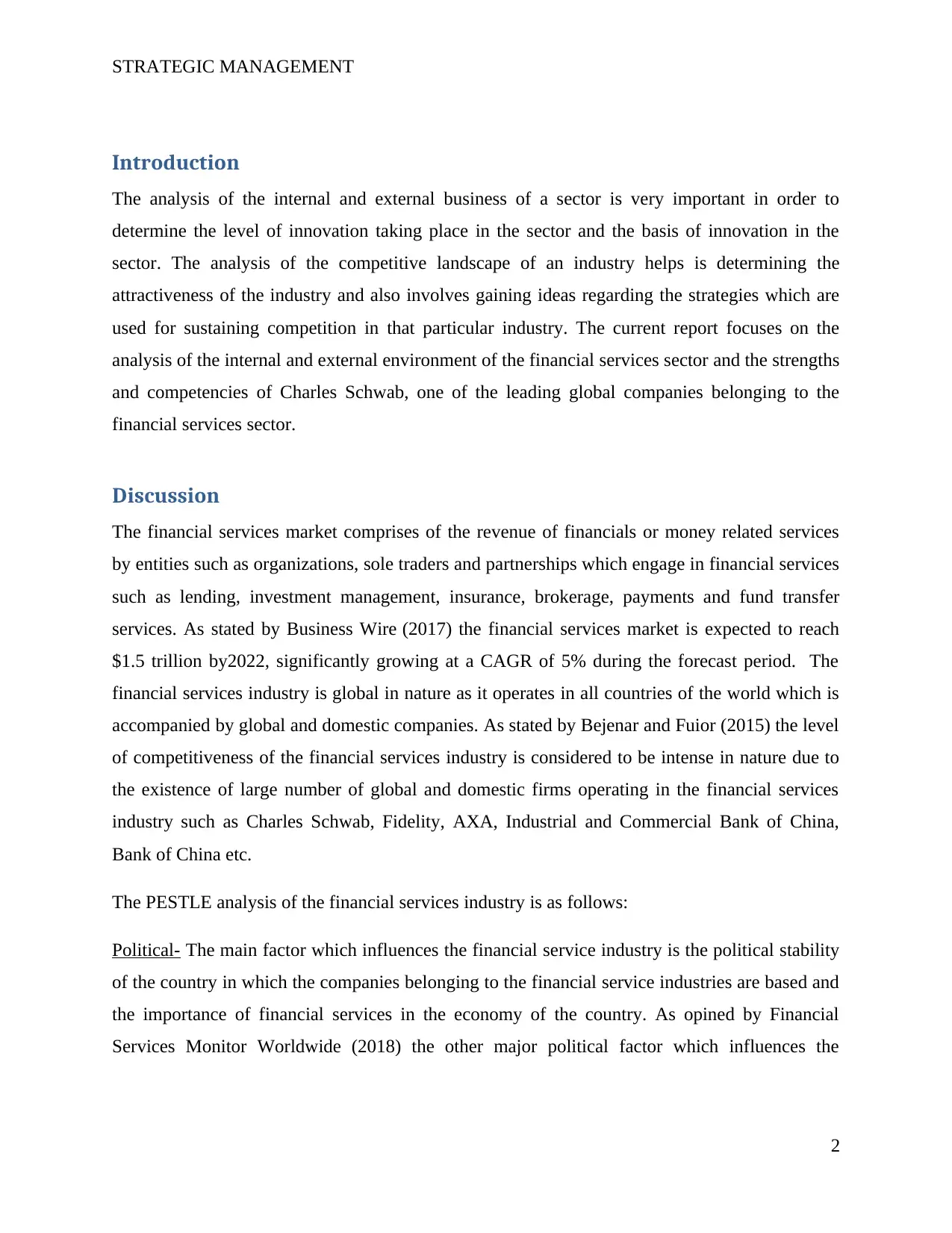
STRATEGIC MANAGEMENT
Introduction
The analysis of the internal and external business of a sector is very important in order to
determine the level of innovation taking place in the sector and the basis of innovation in the
sector. The analysis of the competitive landscape of an industry helps is determining the
attractiveness of the industry and also involves gaining ideas regarding the strategies which are
used for sustaining competition in that particular industry. The current report focuses on the
analysis of the internal and external environment of the financial services sector and the strengths
and competencies of Charles Schwab, one of the leading global companies belonging to the
financial services sector.
Discussion
The financial services market comprises of the revenue of financials or money related services
by entities such as organizations, sole traders and partnerships which engage in financial services
such as lending, investment management, insurance, brokerage, payments and fund transfer
services. As stated by Business Wire (2017) the financial services market is expected to reach
$1.5 trillion by2022, significantly growing at a CAGR of 5% during the forecast period. The
financial services industry is global in nature as it operates in all countries of the world which is
accompanied by global and domestic companies. As stated by Bejenar and Fuior (2015) the level
of competitiveness of the financial services industry is considered to be intense in nature due to
the existence of large number of global and domestic firms operating in the financial services
industry such as Charles Schwab, Fidelity, AXA, Industrial and Commercial Bank of China,
Bank of China etc.
The PESTLE analysis of the financial services industry is as follows:
Political- The main factor which influences the financial service industry is the political stability
of the country in which the companies belonging to the financial service industries are based and
the importance of financial services in the economy of the country. As opined by Financial
Services Monitor Worldwide (2018) the other major political factor which influences the
2
Introduction
The analysis of the internal and external business of a sector is very important in order to
determine the level of innovation taking place in the sector and the basis of innovation in the
sector. The analysis of the competitive landscape of an industry helps is determining the
attractiveness of the industry and also involves gaining ideas regarding the strategies which are
used for sustaining competition in that particular industry. The current report focuses on the
analysis of the internal and external environment of the financial services sector and the strengths
and competencies of Charles Schwab, one of the leading global companies belonging to the
financial services sector.
Discussion
The financial services market comprises of the revenue of financials or money related services
by entities such as organizations, sole traders and partnerships which engage in financial services
such as lending, investment management, insurance, brokerage, payments and fund transfer
services. As stated by Business Wire (2017) the financial services market is expected to reach
$1.5 trillion by2022, significantly growing at a CAGR of 5% during the forecast period. The
financial services industry is global in nature as it operates in all countries of the world which is
accompanied by global and domestic companies. As stated by Bejenar and Fuior (2015) the level
of competitiveness of the financial services industry is considered to be intense in nature due to
the existence of large number of global and domestic firms operating in the financial services
industry such as Charles Schwab, Fidelity, AXA, Industrial and Commercial Bank of China,
Bank of China etc.
The PESTLE analysis of the financial services industry is as follows:
Political- The main factor which influences the financial service industry is the political stability
of the country in which the companies belonging to the financial service industries are based and
the importance of financial services in the economy of the country. As opined by Financial
Services Monitor Worldwide (2018) the other major political factor which influences the
2
⊘ This is a preview!⊘
Do you want full access?
Subscribe today to unlock all pages.

Trusted by 1+ million students worldwide
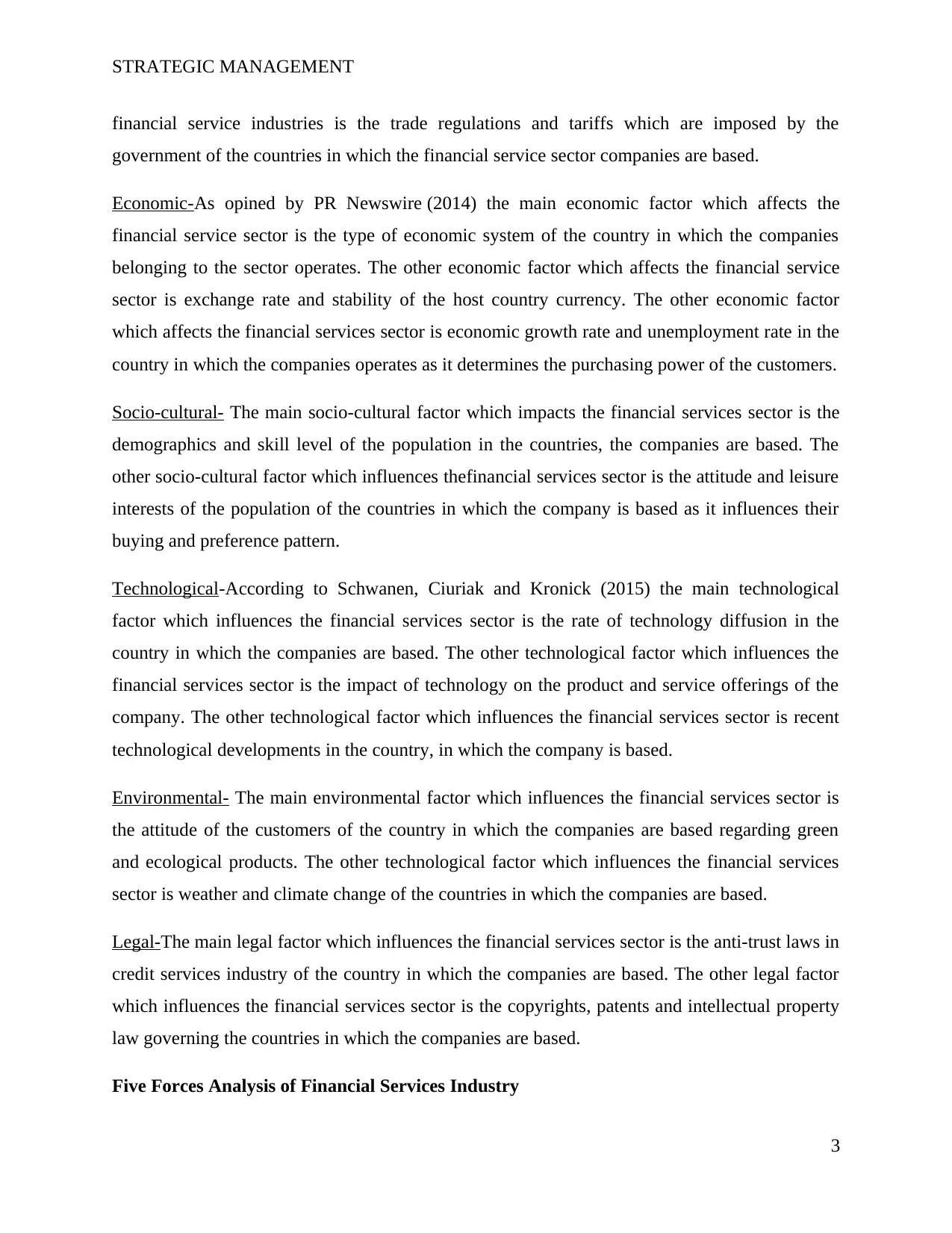
STRATEGIC MANAGEMENT
financial service industries is the trade regulations and tariffs which are imposed by the
government of the countries in which the financial service sector companies are based.
Economic-As opined by PR Newswire (2014) the main economic factor which affects the
financial service sector is the type of economic system of the country in which the companies
belonging to the sector operates. The other economic factor which affects the financial service
sector is exchange rate and stability of the host country currency. The other economic factor
which affects the financial services sector is economic growth rate and unemployment rate in the
country in which the companies operates as it determines the purchasing power of the customers.
Socio-cultural- The main socio-cultural factor which impacts the financial services sector is the
demographics and skill level of the population in the countries, the companies are based. The
other socio-cultural factor which influences thefinancial services sector is the attitude and leisure
interests of the population of the countries in which the company is based as it influences their
buying and preference pattern.
Technological-According to Schwanen, Ciuriak and Kronick (2015) the main technological
factor which influences the financial services sector is the rate of technology diffusion in the
country in which the companies are based. The other technological factor which influences the
financial services sector is the impact of technology on the product and service offerings of the
company. The other technological factor which influences the financial services sector is recent
technological developments in the country, in which the company is based.
Environmental- The main environmental factor which influences the financial services sector is
the attitude of the customers of the country in which the companies are based regarding green
and ecological products. The other technological factor which influences the financial services
sector is weather and climate change of the countries in which the companies are based.
Legal-The main legal factor which influences the financial services sector is the anti-trust laws in
credit services industry of the country in which the companies are based. The other legal factor
which influences the financial services sector is the copyrights, patents and intellectual property
law governing the countries in which the companies are based.
Five Forces Analysis of Financial Services Industry
3
financial service industries is the trade regulations and tariffs which are imposed by the
government of the countries in which the financial service sector companies are based.
Economic-As opined by PR Newswire (2014) the main economic factor which affects the
financial service sector is the type of economic system of the country in which the companies
belonging to the sector operates. The other economic factor which affects the financial service
sector is exchange rate and stability of the host country currency. The other economic factor
which affects the financial services sector is economic growth rate and unemployment rate in the
country in which the companies operates as it determines the purchasing power of the customers.
Socio-cultural- The main socio-cultural factor which impacts the financial services sector is the
demographics and skill level of the population in the countries, the companies are based. The
other socio-cultural factor which influences thefinancial services sector is the attitude and leisure
interests of the population of the countries in which the company is based as it influences their
buying and preference pattern.
Technological-According to Schwanen, Ciuriak and Kronick (2015) the main technological
factor which influences the financial services sector is the rate of technology diffusion in the
country in which the companies are based. The other technological factor which influences the
financial services sector is the impact of technology on the product and service offerings of the
company. The other technological factor which influences the financial services sector is recent
technological developments in the country, in which the company is based.
Environmental- The main environmental factor which influences the financial services sector is
the attitude of the customers of the country in which the companies are based regarding green
and ecological products. The other technological factor which influences the financial services
sector is weather and climate change of the countries in which the companies are based.
Legal-The main legal factor which influences the financial services sector is the anti-trust laws in
credit services industry of the country in which the companies are based. The other legal factor
which influences the financial services sector is the copyrights, patents and intellectual property
law governing the countries in which the companies are based.
Five Forces Analysis of Financial Services Industry
3
Paraphrase This Document
Need a fresh take? Get an instant paraphrase of this document with our AI Paraphraser
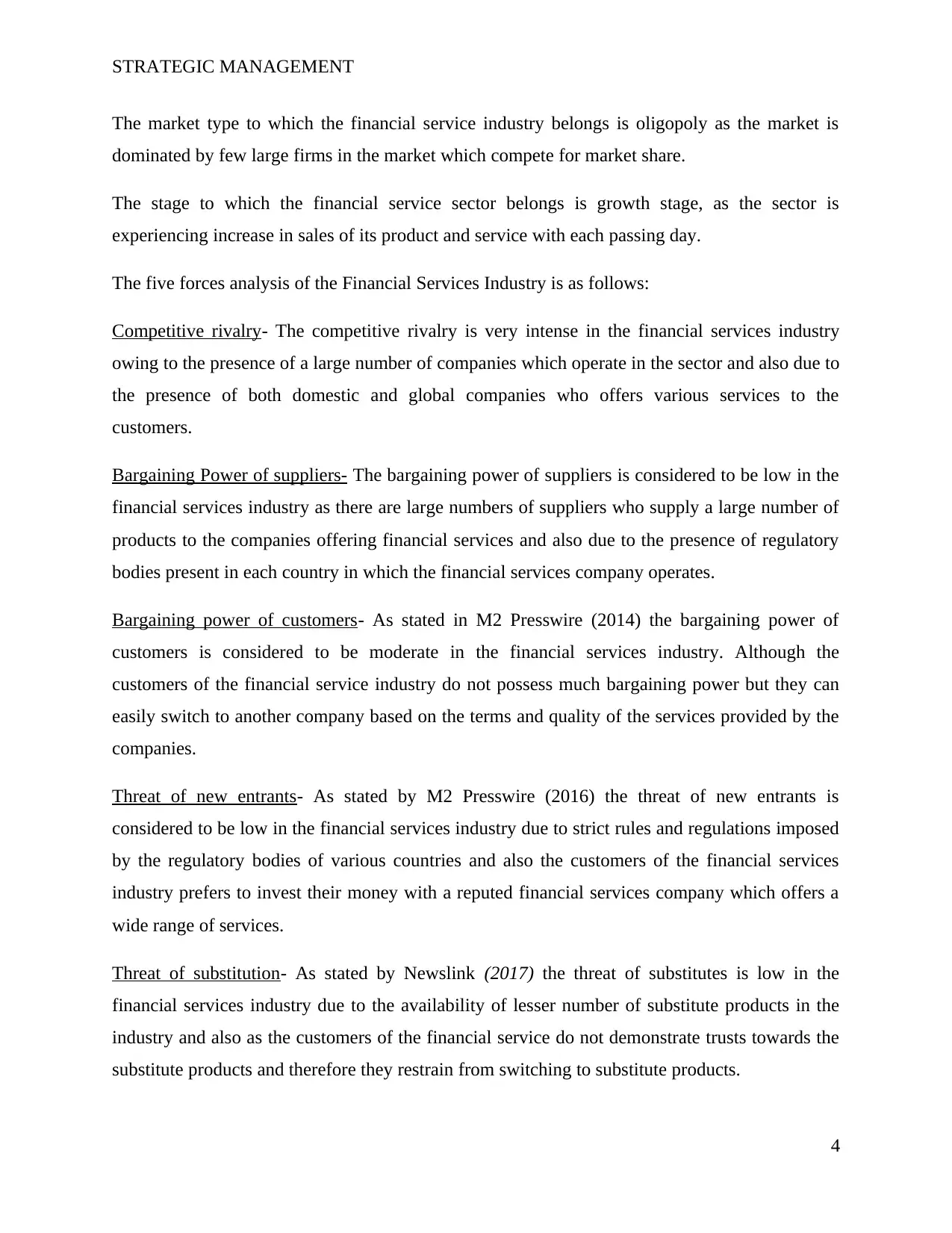
STRATEGIC MANAGEMENT
The market type to which the financial service industry belongs is oligopoly as the market is
dominated by few large firms in the market which compete for market share.
The stage to which the financial service sector belongs is growth stage, as the sector is
experiencing increase in sales of its product and service with each passing day.
The five forces analysis of the Financial Services Industry is as follows:
Competitive rivalry- The competitive rivalry is very intense in the financial services industry
owing to the presence of a large number of companies which operate in the sector and also due to
the presence of both domestic and global companies who offers various services to the
customers.
Bargaining Power of suppliers- The bargaining power of suppliers is considered to be low in the
financial services industry as there are large numbers of suppliers who supply a large number of
products to the companies offering financial services and also due to the presence of regulatory
bodies present in each country in which the financial services company operates.
Bargaining power of customers- As stated in M2 Presswire (2014) the bargaining power of
customers is considered to be moderate in the financial services industry. Although the
customers of the financial service industry do not possess much bargaining power but they can
easily switch to another company based on the terms and quality of the services provided by the
companies.
Threat of new entrants- As stated by M2 Presswire (2016) the threat of new entrants is
considered to be low in the financial services industry due to strict rules and regulations imposed
by the regulatory bodies of various countries and also the customers of the financial services
industry prefers to invest their money with a reputed financial services company which offers a
wide range of services.
Threat of substitution- As stated by Newslink (2017) the threat of substitutes is low in the
financial services industry due to the availability of lesser number of substitute products in the
industry and also as the customers of the financial service do not demonstrate trusts towards the
substitute products and therefore they restrain from switching to substitute products.
4
The market type to which the financial service industry belongs is oligopoly as the market is
dominated by few large firms in the market which compete for market share.
The stage to which the financial service sector belongs is growth stage, as the sector is
experiencing increase in sales of its product and service with each passing day.
The five forces analysis of the Financial Services Industry is as follows:
Competitive rivalry- The competitive rivalry is very intense in the financial services industry
owing to the presence of a large number of companies which operate in the sector and also due to
the presence of both domestic and global companies who offers various services to the
customers.
Bargaining Power of suppliers- The bargaining power of suppliers is considered to be low in the
financial services industry as there are large numbers of suppliers who supply a large number of
products to the companies offering financial services and also due to the presence of regulatory
bodies present in each country in which the financial services company operates.
Bargaining power of customers- As stated in M2 Presswire (2014) the bargaining power of
customers is considered to be moderate in the financial services industry. Although the
customers of the financial service industry do not possess much bargaining power but they can
easily switch to another company based on the terms and quality of the services provided by the
companies.
Threat of new entrants- As stated by M2 Presswire (2016) the threat of new entrants is
considered to be low in the financial services industry due to strict rules and regulations imposed
by the regulatory bodies of various countries and also the customers of the financial services
industry prefers to invest their money with a reputed financial services company which offers a
wide range of services.
Threat of substitution- As stated by Newslink (2017) the threat of substitutes is low in the
financial services industry due to the availability of lesser number of substitute products in the
industry and also as the customers of the financial service do not demonstrate trusts towards the
substitute products and therefore they restrain from switching to substitute products.
4
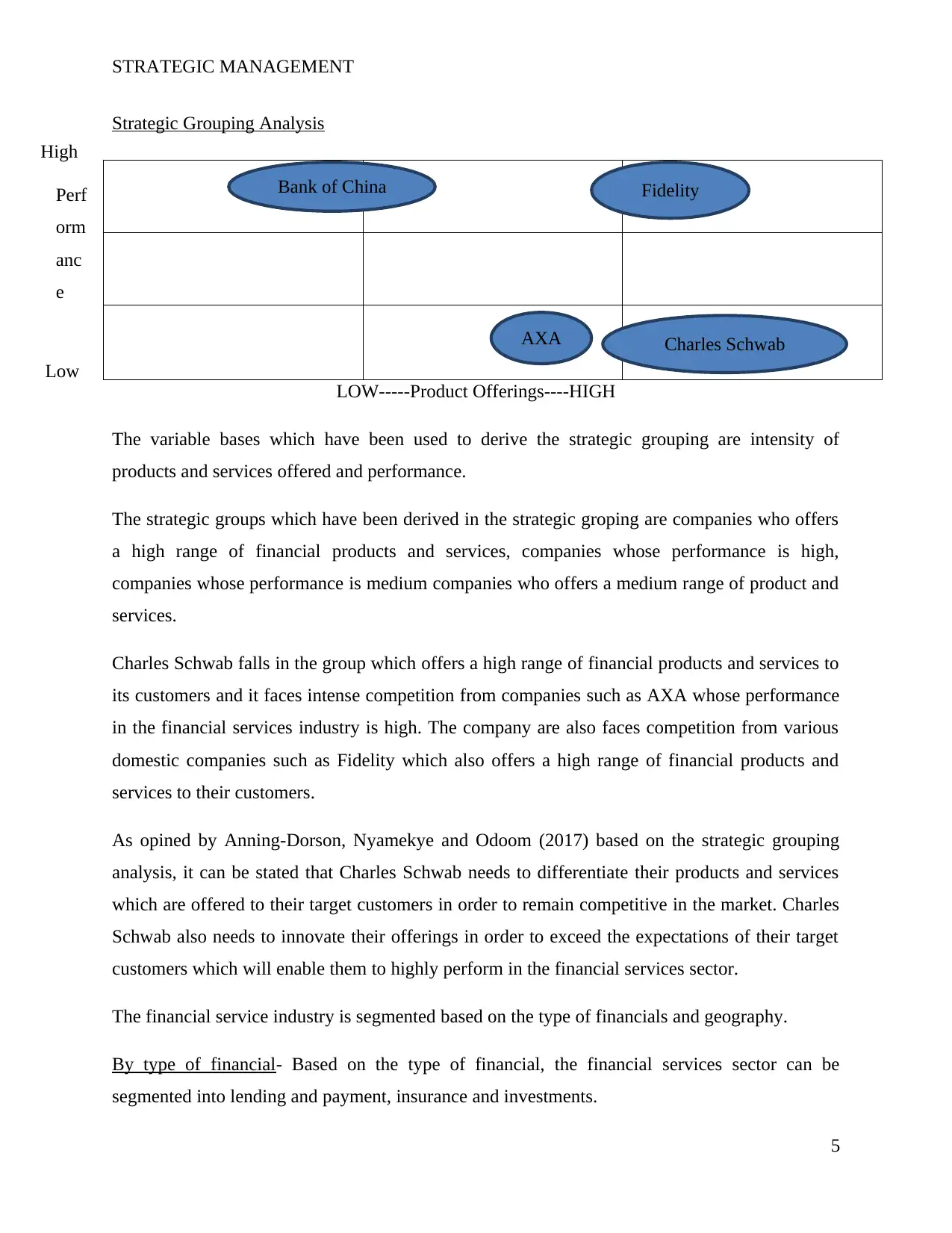
STRATEGIC MANAGEMENT
Strategic Grouping Analysis
LOW-----Product Offerings----HIGH
The variable bases which have been used to derive the strategic grouping are intensity of
products and services offered and performance.
The strategic groups which have been derived in the strategic groping are companies who offers
a high range of financial products and services, companies whose performance is high,
companies whose performance is medium companies who offers a medium range of product and
services.
Charles Schwab falls in the group which offers a high range of financial products and services to
its customers and it faces intense competition from companies such as AXA whose performance
in the financial services industry is high. The company are also faces competition from various
domestic companies such as Fidelity which also offers a high range of financial products and
services to their customers.
As opined by Anning-Dorson, Nyamekye and Odoom (2017) based on the strategic grouping
analysis, it can be stated that Charles Schwab needs to differentiate their products and services
which are offered to their target customers in order to remain competitive in the market. Charles
Schwab also needs to innovate their offerings in order to exceed the expectations of their target
customers which will enable them to highly perform in the financial services sector.
The financial service industry is segmented based on the type of financials and geography.
By type of financial- Based on the type of financial, the financial services sector can be
segmented into lending and payment, insurance and investments.
5
Charles Schwab
Bank of China Fidelity
AXA
Perf
orm
anc
e
Low
High
Strategic Grouping Analysis
LOW-----Product Offerings----HIGH
The variable bases which have been used to derive the strategic grouping are intensity of
products and services offered and performance.
The strategic groups which have been derived in the strategic groping are companies who offers
a high range of financial products and services, companies whose performance is high,
companies whose performance is medium companies who offers a medium range of product and
services.
Charles Schwab falls in the group which offers a high range of financial products and services to
its customers and it faces intense competition from companies such as AXA whose performance
in the financial services industry is high. The company are also faces competition from various
domestic companies such as Fidelity which also offers a high range of financial products and
services to their customers.
As opined by Anning-Dorson, Nyamekye and Odoom (2017) based on the strategic grouping
analysis, it can be stated that Charles Schwab needs to differentiate their products and services
which are offered to their target customers in order to remain competitive in the market. Charles
Schwab also needs to innovate their offerings in order to exceed the expectations of their target
customers which will enable them to highly perform in the financial services sector.
The financial service industry is segmented based on the type of financials and geography.
By type of financial- Based on the type of financial, the financial services sector can be
segmented into lending and payment, insurance and investments.
5
Charles Schwab
Bank of China Fidelity
AXA
Perf
orm
anc
e
Low
High
⊘ This is a preview!⊘
Do you want full access?
Subscribe today to unlock all pages.

Trusted by 1+ million students worldwide
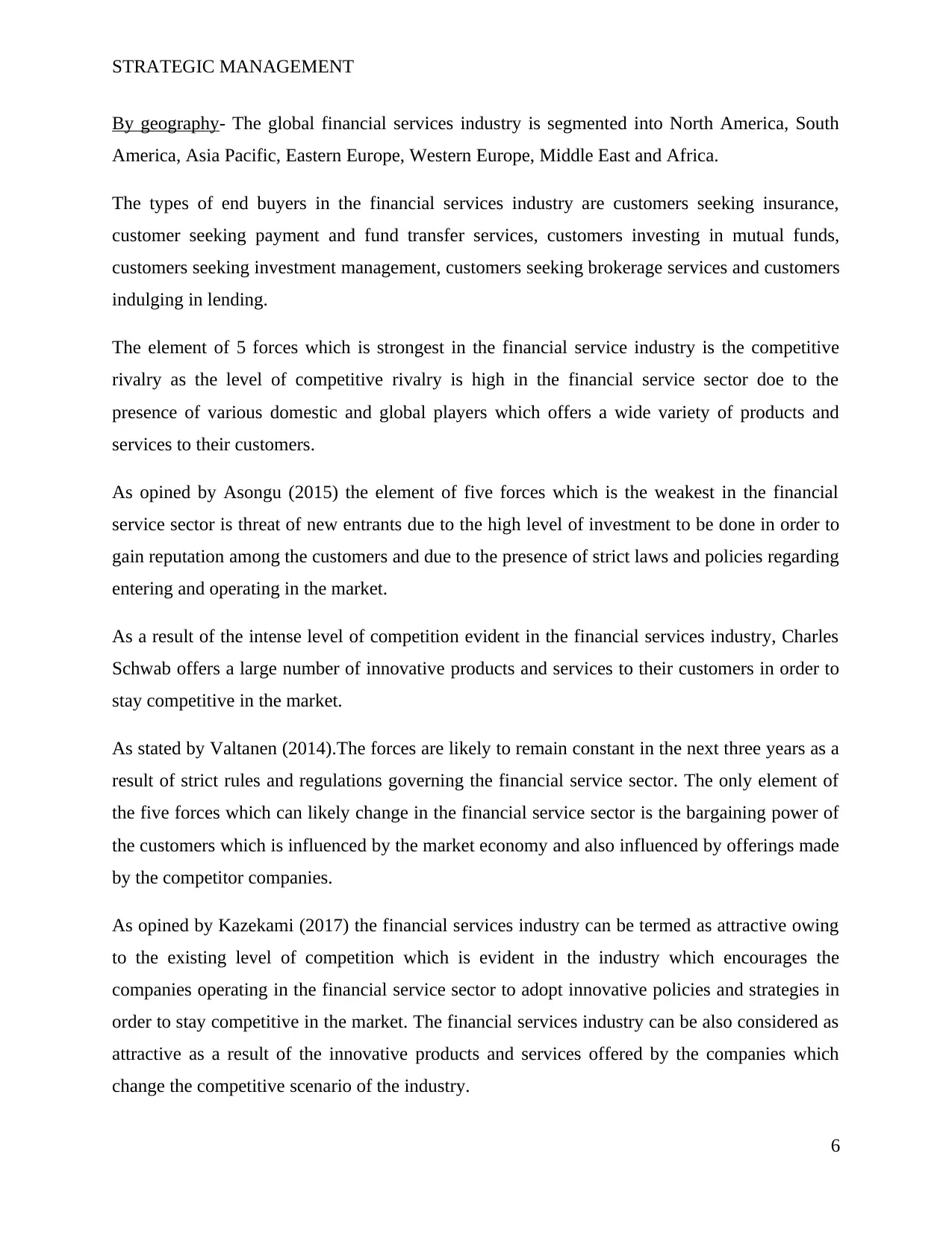
STRATEGIC MANAGEMENT
By geography- The global financial services industry is segmented into North America, South
America, Asia Pacific, Eastern Europe, Western Europe, Middle East and Africa.
The types of end buyers in the financial services industry are customers seeking insurance,
customer seeking payment and fund transfer services, customers investing in mutual funds,
customers seeking investment management, customers seeking brokerage services and customers
indulging in lending.
The element of 5 forces which is strongest in the financial service industry is the competitive
rivalry as the level of competitive rivalry is high in the financial service sector doe to the
presence of various domestic and global players which offers a wide variety of products and
services to their customers.
As opined by Asongu (2015) the element of five forces which is the weakest in the financial
service sector is threat of new entrants due to the high level of investment to be done in order to
gain reputation among the customers and due to the presence of strict laws and policies regarding
entering and operating in the market.
As a result of the intense level of competition evident in the financial services industry, Charles
Schwab offers a large number of innovative products and services to their customers in order to
stay competitive in the market.
As stated by Valtanen (2014).The forces are likely to remain constant in the next three years as a
result of strict rules and regulations governing the financial service sector. The only element of
the five forces which can likely change in the financial service sector is the bargaining power of
the customers which is influenced by the market economy and also influenced by offerings made
by the competitor companies.
As opined by Kazekami (2017) the financial services industry can be termed as attractive owing
to the existing level of competition which is evident in the industry which encourages the
companies operating in the financial service sector to adopt innovative policies and strategies in
order to stay competitive in the market. The financial services industry can be also considered as
attractive as a result of the innovative products and services offered by the companies which
change the competitive scenario of the industry.
6
By geography- The global financial services industry is segmented into North America, South
America, Asia Pacific, Eastern Europe, Western Europe, Middle East and Africa.
The types of end buyers in the financial services industry are customers seeking insurance,
customer seeking payment and fund transfer services, customers investing in mutual funds,
customers seeking investment management, customers seeking brokerage services and customers
indulging in lending.
The element of 5 forces which is strongest in the financial service industry is the competitive
rivalry as the level of competitive rivalry is high in the financial service sector doe to the
presence of various domestic and global players which offers a wide variety of products and
services to their customers.
As opined by Asongu (2015) the element of five forces which is the weakest in the financial
service sector is threat of new entrants due to the high level of investment to be done in order to
gain reputation among the customers and due to the presence of strict laws and policies regarding
entering and operating in the market.
As a result of the intense level of competition evident in the financial services industry, Charles
Schwab offers a large number of innovative products and services to their customers in order to
stay competitive in the market.
As stated by Valtanen (2014).The forces are likely to remain constant in the next three years as a
result of strict rules and regulations governing the financial service sector. The only element of
the five forces which can likely change in the financial service sector is the bargaining power of
the customers which is influenced by the market economy and also influenced by offerings made
by the competitor companies.
As opined by Kazekami (2017) the financial services industry can be termed as attractive owing
to the existing level of competition which is evident in the industry which encourages the
companies operating in the financial service sector to adopt innovative policies and strategies in
order to stay competitive in the market. The financial services industry can be also considered as
attractive as a result of the innovative products and services offered by the companies which
change the competitive scenario of the industry.
6
Paraphrase This Document
Need a fresh take? Get an instant paraphrase of this document with our AI Paraphraser
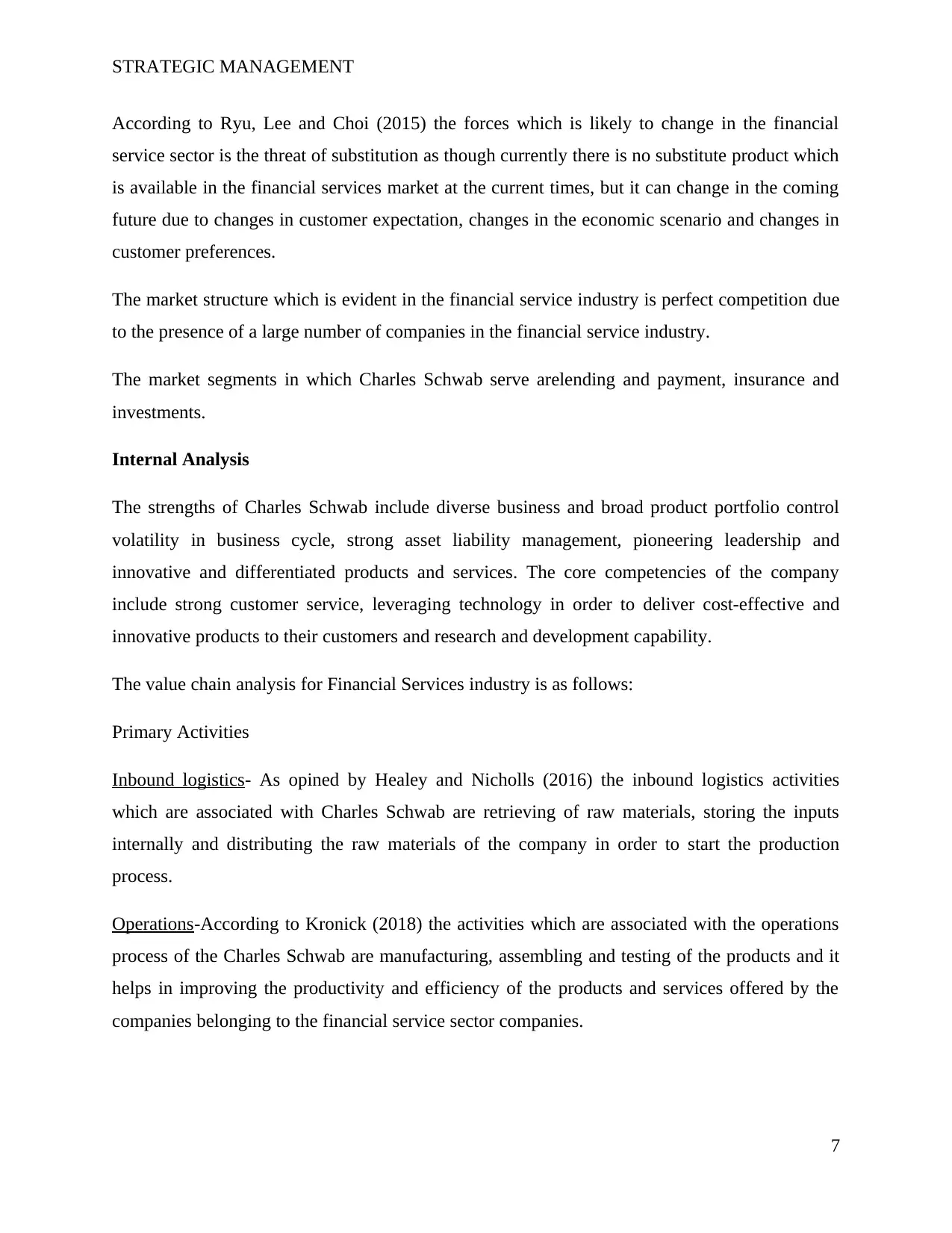
STRATEGIC MANAGEMENT
According to Ryu, Lee and Choi (2015) the forces which is likely to change in the financial
service sector is the threat of substitution as though currently there is no substitute product which
is available in the financial services market at the current times, but it can change in the coming
future due to changes in customer expectation, changes in the economic scenario and changes in
customer preferences.
The market structure which is evident in the financial service industry is perfect competition due
to the presence of a large number of companies in the financial service industry.
The market segments in which Charles Schwab serve arelending and payment, insurance and
investments.
Internal Analysis
The strengths of Charles Schwab include diverse business and broad product portfolio control
volatility in business cycle, strong asset liability management, pioneering leadership and
innovative and differentiated products and services. The core competencies of the company
include strong customer service, leveraging technology in order to deliver cost-effective and
innovative products to their customers and research and development capability.
The value chain analysis for Financial Services industry is as follows:
Primary Activities
Inbound logistics- As opined by Healey and Nicholls (2016) the inbound logistics activities
which are associated with Charles Schwab are retrieving of raw materials, storing the inputs
internally and distributing the raw materials of the company in order to start the production
process.
Operations-According to Kronick (2018) the activities which are associated with the operations
process of the Charles Schwab are manufacturing, assembling and testing of the products and it
helps in improving the productivity and efficiency of the products and services offered by the
companies belonging to the financial service sector companies.
7
According to Ryu, Lee and Choi (2015) the forces which is likely to change in the financial
service sector is the threat of substitution as though currently there is no substitute product which
is available in the financial services market at the current times, but it can change in the coming
future due to changes in customer expectation, changes in the economic scenario and changes in
customer preferences.
The market structure which is evident in the financial service industry is perfect competition due
to the presence of a large number of companies in the financial service industry.
The market segments in which Charles Schwab serve arelending and payment, insurance and
investments.
Internal Analysis
The strengths of Charles Schwab include diverse business and broad product portfolio control
volatility in business cycle, strong asset liability management, pioneering leadership and
innovative and differentiated products and services. The core competencies of the company
include strong customer service, leveraging technology in order to deliver cost-effective and
innovative products to their customers and research and development capability.
The value chain analysis for Financial Services industry is as follows:
Primary Activities
Inbound logistics- As opined by Healey and Nicholls (2016) the inbound logistics activities
which are associated with Charles Schwab are retrieving of raw materials, storing the inputs
internally and distributing the raw materials of the company in order to start the production
process.
Operations-According to Kronick (2018) the activities which are associated with the operations
process of the Charles Schwab are manufacturing, assembling and testing of the products and it
helps in improving the productivity and efficiency of the products and services offered by the
companies belonging to the financial service sector companies.
7
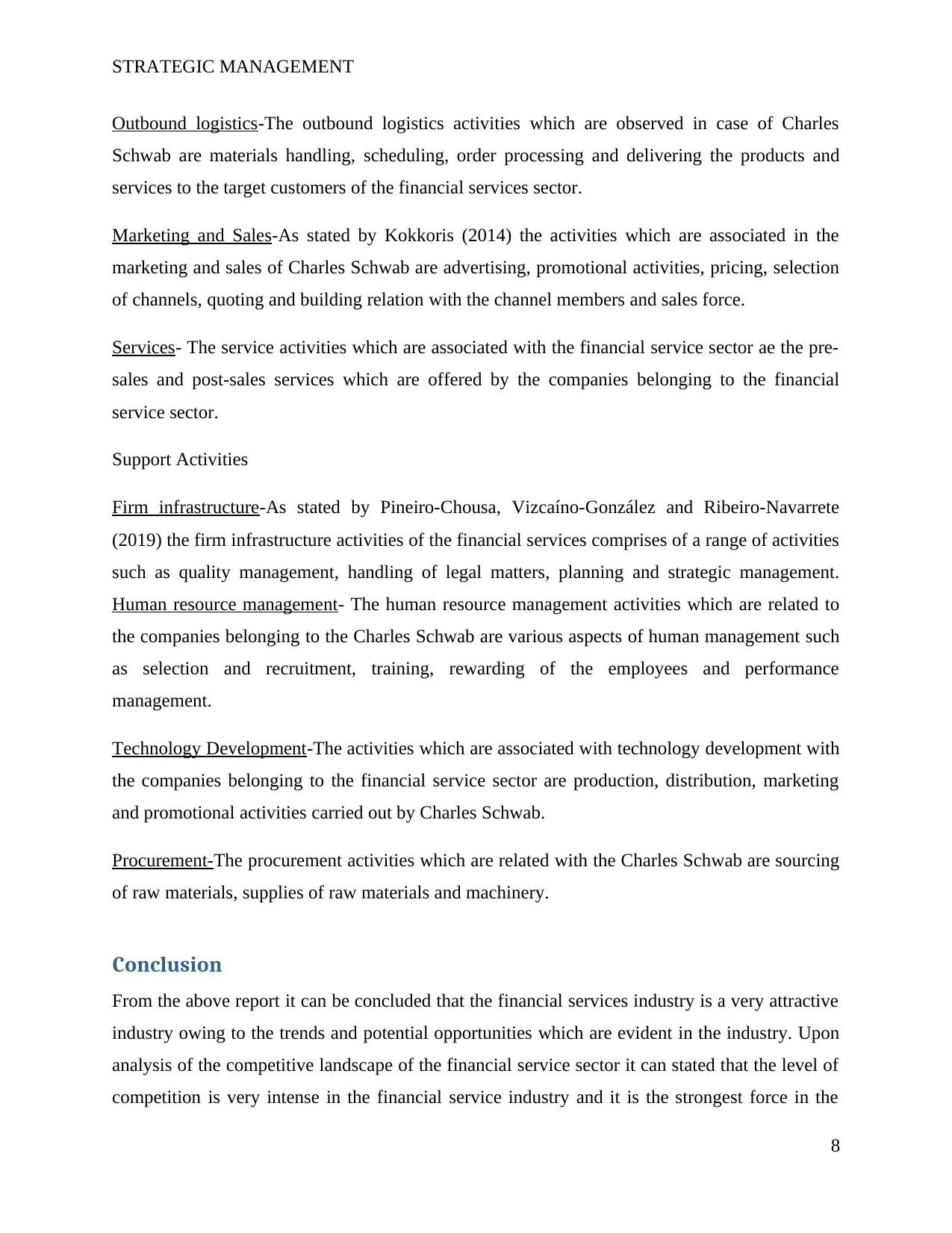
STRATEGIC MANAGEMENT
Outbound logistics-The outbound logistics activities which are observed in case of Charles
Schwab are materials handling, scheduling, order processing and delivering the products and
services to the target customers of the financial services sector.
Marketing and Sales-As stated by Kokkoris (2014) the activities which are associated in the
marketing and sales of Charles Schwab are advertising, promotional activities, pricing, selection
of channels, quoting and building relation with the channel members and sales force.
Services- The service activities which are associated with the financial service sector ae the pre-
sales and post-sales services which are offered by the companies belonging to the financial
service sector.
Support Activities
Firm infrastructure-As stated by Pineiro-Chousa, Vizcaíno-González and Ribeiro-Navarrete
(2019) the firm infrastructure activities of the financial services comprises of a range of activities
such as quality management, handling of legal matters, planning and strategic management.
Human resource management- The human resource management activities which are related to
the companies belonging to the Charles Schwab are various aspects of human management such
as selection and recruitment, training, rewarding of the employees and performance
management.
Technology Development-The activities which are associated with technology development with
the companies belonging to the financial service sector are production, distribution, marketing
and promotional activities carried out by Charles Schwab.
Procurement-The procurement activities which are related with the Charles Schwab are sourcing
of raw materials, supplies of raw materials and machinery.
Conclusion
From the above report it can be concluded that the financial services industry is a very attractive
industry owing to the trends and potential opportunities which are evident in the industry. Upon
analysis of the competitive landscape of the financial service sector it can stated that the level of
competition is very intense in the financial service industry and it is the strongest force in the
8
Outbound logistics-The outbound logistics activities which are observed in case of Charles
Schwab are materials handling, scheduling, order processing and delivering the products and
services to the target customers of the financial services sector.
Marketing and Sales-As stated by Kokkoris (2014) the activities which are associated in the
marketing and sales of Charles Schwab are advertising, promotional activities, pricing, selection
of channels, quoting and building relation with the channel members and sales force.
Services- The service activities which are associated with the financial service sector ae the pre-
sales and post-sales services which are offered by the companies belonging to the financial
service sector.
Support Activities
Firm infrastructure-As stated by Pineiro-Chousa, Vizcaíno-González and Ribeiro-Navarrete
(2019) the firm infrastructure activities of the financial services comprises of a range of activities
such as quality management, handling of legal matters, planning and strategic management.
Human resource management- The human resource management activities which are related to
the companies belonging to the Charles Schwab are various aspects of human management such
as selection and recruitment, training, rewarding of the employees and performance
management.
Technology Development-The activities which are associated with technology development with
the companies belonging to the financial service sector are production, distribution, marketing
and promotional activities carried out by Charles Schwab.
Procurement-The procurement activities which are related with the Charles Schwab are sourcing
of raw materials, supplies of raw materials and machinery.
Conclusion
From the above report it can be concluded that the financial services industry is a very attractive
industry owing to the trends and potential opportunities which are evident in the industry. Upon
analysis of the competitive landscape of the financial service sector it can stated that the level of
competition is very intense in the financial service industry and it is the strongest force in the
8
⊘ This is a preview!⊘
Do you want full access?
Subscribe today to unlock all pages.

Trusted by 1+ million students worldwide
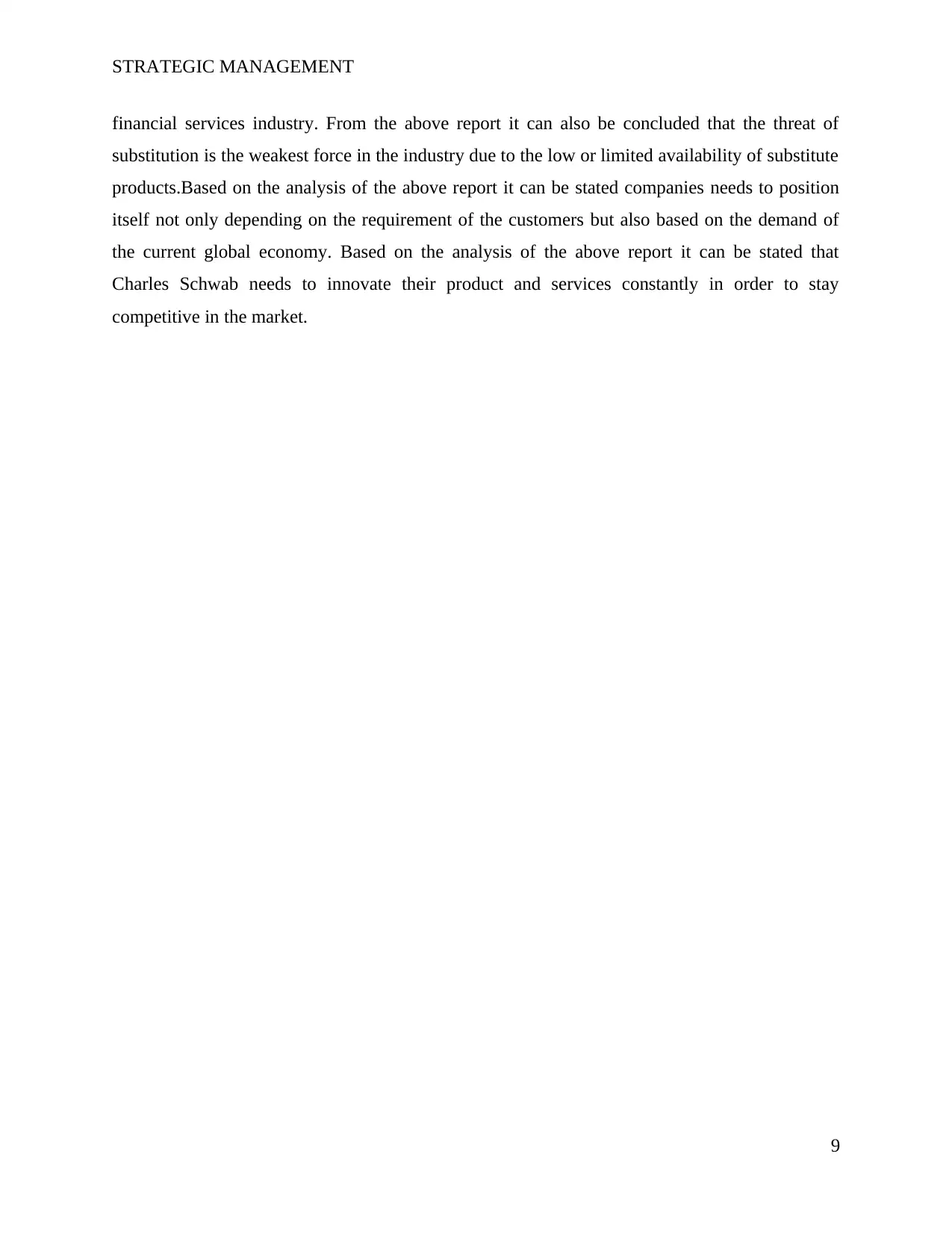
STRATEGIC MANAGEMENT
financial services industry. From the above report it can also be concluded that the threat of
substitution is the weakest force in the industry due to the low or limited availability of substitute
products.Based on the analysis of the above report it can be stated companies needs to position
itself not only depending on the requirement of the customers but also based on the demand of
the current global economy. Based on the analysis of the above report it can be stated that
Charles Schwab needs to innovate their product and services constantly in order to stay
competitive in the market.
9
financial services industry. From the above report it can also be concluded that the threat of
substitution is the weakest force in the industry due to the low or limited availability of substitute
products.Based on the analysis of the above report it can be stated companies needs to position
itself not only depending on the requirement of the customers but also based on the demand of
the current global economy. Based on the analysis of the above report it can be stated that
Charles Schwab needs to innovate their product and services constantly in order to stay
competitive in the market.
9
Paraphrase This Document
Need a fresh take? Get an instant paraphrase of this document with our AI Paraphraser
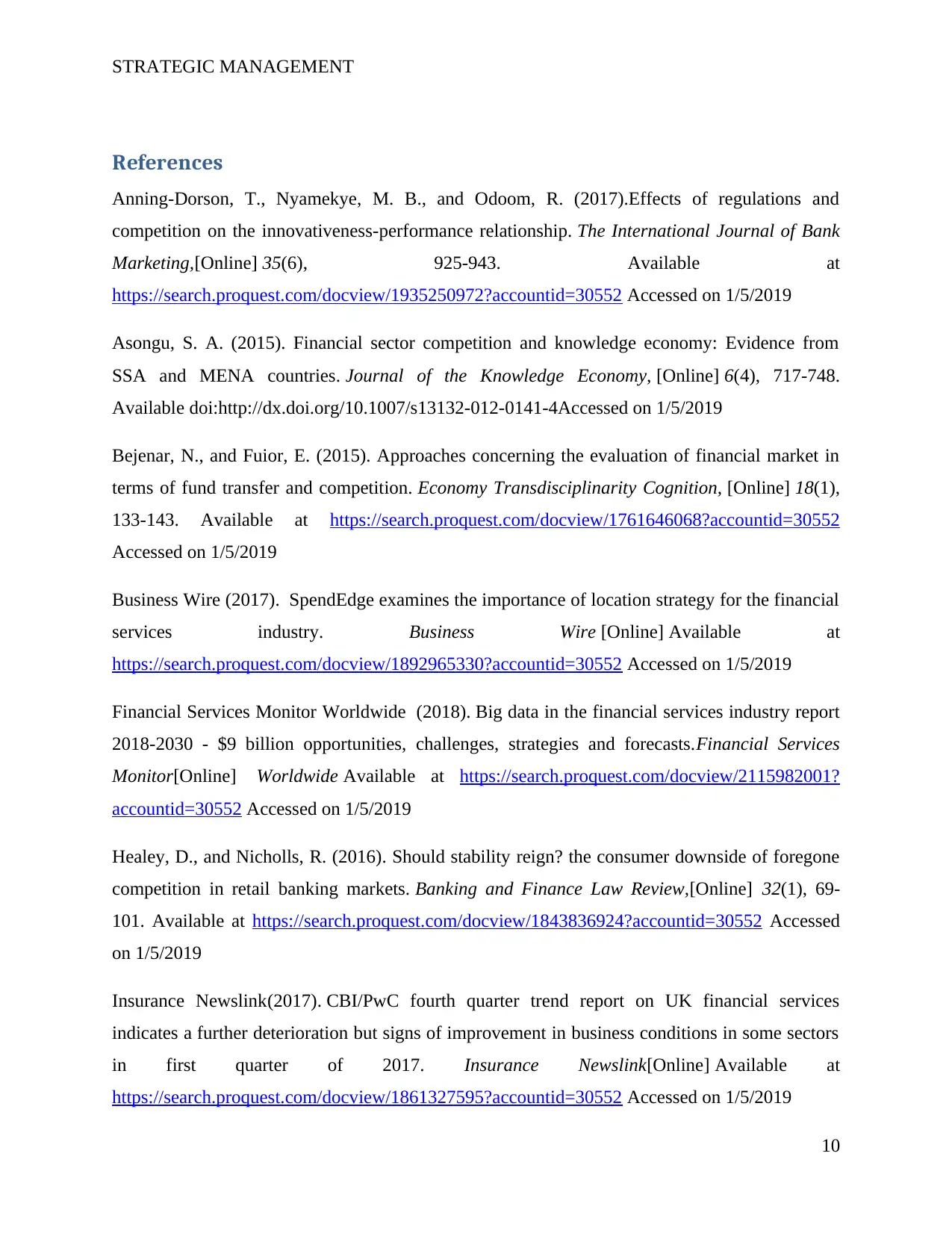
STRATEGIC MANAGEMENT
References
Anning-Dorson, T., Nyamekye, M. B., and Odoom, R. (2017).Effects of regulations and
competition on the innovativeness-performance relationship. The International Journal of Bank
Marketing,[Online] 35(6), 925-943. Available at
https://search.proquest.com/docview/1935250972?accountid=30552 Accessed on 1/5/2019
Asongu, S. A. (2015). Financial sector competition and knowledge economy: Evidence from
SSA and MENA countries. Journal of the Knowledge Economy, [Online] 6(4), 717-748.
Available doi:http://dx.doi.org/10.1007/s13132-012-0141-4Accessed on 1/5/2019
Bejenar, N., and Fuior, E. (2015). Approaches concerning the evaluation of financial market in
terms of fund transfer and competition. Economy Transdisciplinarity Cognition, [Online] 18(1),
133-143. Available at https://search.proquest.com/docview/1761646068?accountid=30552
Accessed on 1/5/2019
Business Wire (2017). SpendEdge examines the importance of location strategy for the financial
services industry. Business Wire [Online] Available at
https://search.proquest.com/docview/1892965330?accountid=30552 Accessed on 1/5/2019
Financial Services Monitor Worldwide (2018). Big data in the financial services industry report
2018-2030 - $9 billion opportunities, challenges, strategies and forecasts.Financial Services
Monitor[Online] Worldwide Available at https://search.proquest.com/docview/2115982001?
accountid=30552 Accessed on 1/5/2019
Healey, D., and Nicholls, R. (2016). Should stability reign? the consumer downside of foregone
competition in retail banking markets. Banking and Finance Law Review,[Online] 32(1), 69-
101. Available at https://search.proquest.com/docview/1843836924?accountid=30552 Accessed
on 1/5/2019
Insurance Newslink(2017). CBI/PwC fourth quarter trend report on UK financial services
indicates a further deterioration but signs of improvement in business conditions in some sectors
in first quarter of 2017. Insurance Newslink[Online] Available at
https://search.proquest.com/docview/1861327595?accountid=30552 Accessed on 1/5/2019
10
References
Anning-Dorson, T., Nyamekye, M. B., and Odoom, R. (2017).Effects of regulations and
competition on the innovativeness-performance relationship. The International Journal of Bank
Marketing,[Online] 35(6), 925-943. Available at
https://search.proquest.com/docview/1935250972?accountid=30552 Accessed on 1/5/2019
Asongu, S. A. (2015). Financial sector competition and knowledge economy: Evidence from
SSA and MENA countries. Journal of the Knowledge Economy, [Online] 6(4), 717-748.
Available doi:http://dx.doi.org/10.1007/s13132-012-0141-4Accessed on 1/5/2019
Bejenar, N., and Fuior, E. (2015). Approaches concerning the evaluation of financial market in
terms of fund transfer and competition. Economy Transdisciplinarity Cognition, [Online] 18(1),
133-143. Available at https://search.proquest.com/docview/1761646068?accountid=30552
Accessed on 1/5/2019
Business Wire (2017). SpendEdge examines the importance of location strategy for the financial
services industry. Business Wire [Online] Available at
https://search.proquest.com/docview/1892965330?accountid=30552 Accessed on 1/5/2019
Financial Services Monitor Worldwide (2018). Big data in the financial services industry report
2018-2030 - $9 billion opportunities, challenges, strategies and forecasts.Financial Services
Monitor[Online] Worldwide Available at https://search.proquest.com/docview/2115982001?
accountid=30552 Accessed on 1/5/2019
Healey, D., and Nicholls, R. (2016). Should stability reign? the consumer downside of foregone
competition in retail banking markets. Banking and Finance Law Review,[Online] 32(1), 69-
101. Available at https://search.proquest.com/docview/1843836924?accountid=30552 Accessed
on 1/5/2019
Insurance Newslink(2017). CBI/PwC fourth quarter trend report on UK financial services
indicates a further deterioration but signs of improvement in business conditions in some sectors
in first quarter of 2017. Insurance Newslink[Online] Available at
https://search.proquest.com/docview/1861327595?accountid=30552 Accessed on 1/5/2019
10
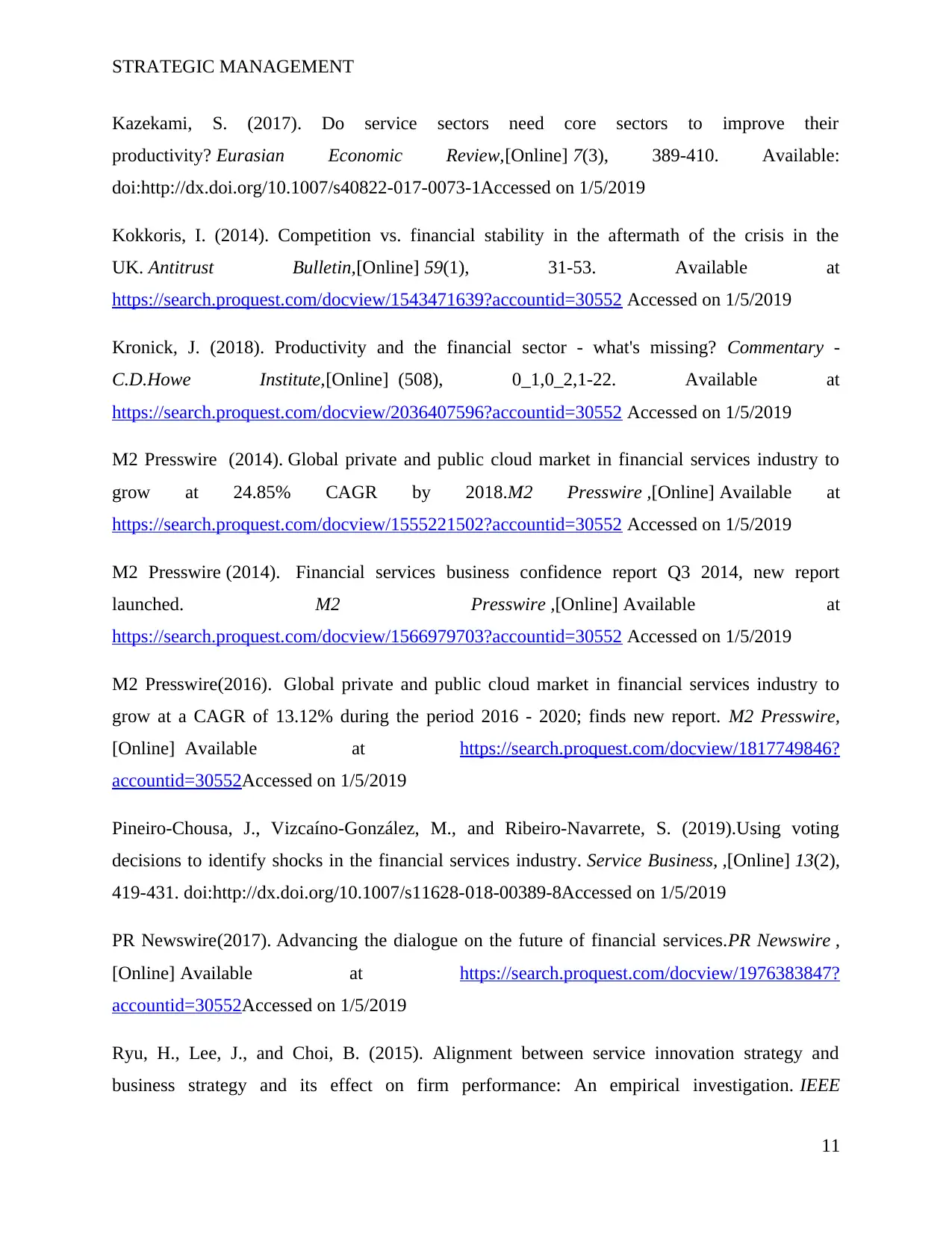
STRATEGIC MANAGEMENT
Kazekami, S. (2017). Do service sectors need core sectors to improve their
productivity? Eurasian Economic Review,[Online] 7(3), 389-410. Available:
doi:http://dx.doi.org/10.1007/s40822-017-0073-1Accessed on 1/5/2019
Kokkoris, I. (2014). Competition vs. financial stability in the aftermath of the crisis in the
UK. Antitrust Bulletin,[Online] 59(1), 31-53. Available at
https://search.proquest.com/docview/1543471639?accountid=30552 Accessed on 1/5/2019
Kronick, J. (2018). Productivity and the financial sector - what's missing? Commentary -
C.D.Howe Institute,[Online] (508), 0_1,0_2,1-22. Available at
https://search.proquest.com/docview/2036407596?accountid=30552 Accessed on 1/5/2019
M2 Presswire (2014). Global private and public cloud market in financial services industry to
grow at 24.85% CAGR by 2018.M2 Presswire ,[Online] Available at
https://search.proquest.com/docview/1555221502?accountid=30552 Accessed on 1/5/2019
M2 Presswire (2014). Financial services business confidence report Q3 2014, new report
launched. M2 Presswire ,[Online] Available at
https://search.proquest.com/docview/1566979703?accountid=30552 Accessed on 1/5/2019
M2 Presswire(2016). Global private and public cloud market in financial services industry to
grow at a CAGR of 13.12% during the period 2016 - 2020; finds new report. M2 Presswire,
[Online] Available at https://search.proquest.com/docview/1817749846?
accountid=30552Accessed on 1/5/2019
Pineiro-Chousa, J., Vizcaíno-González, M., and Ribeiro-Navarrete, S. (2019).Using voting
decisions to identify shocks in the financial services industry. Service Business, ,[Online] 13(2),
419-431. doi:http://dx.doi.org/10.1007/s11628-018-00389-8Accessed on 1/5/2019
PR Newswire(2017). Advancing the dialogue on the future of financial services.PR Newswire ,
[Online] Available at https://search.proquest.com/docview/1976383847?
accountid=30552Accessed on 1/5/2019
Ryu, H., Lee, J., and Choi, B. (2015). Alignment between service innovation strategy and
business strategy and its effect on firm performance: An empirical investigation. IEEE
11
Kazekami, S. (2017). Do service sectors need core sectors to improve their
productivity? Eurasian Economic Review,[Online] 7(3), 389-410. Available:
doi:http://dx.doi.org/10.1007/s40822-017-0073-1Accessed on 1/5/2019
Kokkoris, I. (2014). Competition vs. financial stability in the aftermath of the crisis in the
UK. Antitrust Bulletin,[Online] 59(1), 31-53. Available at
https://search.proquest.com/docview/1543471639?accountid=30552 Accessed on 1/5/2019
Kronick, J. (2018). Productivity and the financial sector - what's missing? Commentary -
C.D.Howe Institute,[Online] (508), 0_1,0_2,1-22. Available at
https://search.proquest.com/docview/2036407596?accountid=30552 Accessed on 1/5/2019
M2 Presswire (2014). Global private and public cloud market in financial services industry to
grow at 24.85% CAGR by 2018.M2 Presswire ,[Online] Available at
https://search.proquest.com/docview/1555221502?accountid=30552 Accessed on 1/5/2019
M2 Presswire (2014). Financial services business confidence report Q3 2014, new report
launched. M2 Presswire ,[Online] Available at
https://search.proquest.com/docview/1566979703?accountid=30552 Accessed on 1/5/2019
M2 Presswire(2016). Global private and public cloud market in financial services industry to
grow at a CAGR of 13.12% during the period 2016 - 2020; finds new report. M2 Presswire,
[Online] Available at https://search.proquest.com/docview/1817749846?
accountid=30552Accessed on 1/5/2019
Pineiro-Chousa, J., Vizcaíno-González, M., and Ribeiro-Navarrete, S. (2019).Using voting
decisions to identify shocks in the financial services industry. Service Business, ,[Online] 13(2),
419-431. doi:http://dx.doi.org/10.1007/s11628-018-00389-8Accessed on 1/5/2019
PR Newswire(2017). Advancing the dialogue on the future of financial services.PR Newswire ,
[Online] Available at https://search.proquest.com/docview/1976383847?
accountid=30552Accessed on 1/5/2019
Ryu, H., Lee, J., and Choi, B. (2015). Alignment between service innovation strategy and
business strategy and its effect on firm performance: An empirical investigation. IEEE
11
⊘ This is a preview!⊘
Do you want full access?
Subscribe today to unlock all pages.

Trusted by 1+ million students worldwide
1 out of 13
Related Documents
Your All-in-One AI-Powered Toolkit for Academic Success.
+13062052269
info@desklib.com
Available 24*7 on WhatsApp / Email
![[object Object]](/_next/static/media/star-bottom.7253800d.svg)
Unlock your academic potential
Copyright © 2020–2025 A2Z Services. All Rights Reserved. Developed and managed by ZUCOL.




